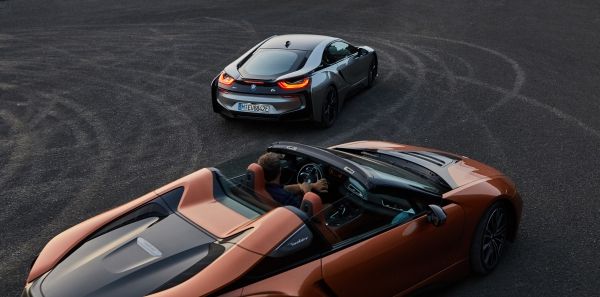I Think I8 Can: Will a Refresh and Extra Range Give BMW's Fading Eco Supercar a Boost?

When it went on sale in the latter part of 2014, BMW’s i8 was something of a sensation, though the enthusiasm had as much to do with the car’s jarring design as its technology. I seem to recall Tom Cruise tooling around Dubai in one, possibly in one of the 87 Mission Impossible films.
Boasting scissor type doors, a plug-in hybrid powertrain, a backseat you’d never want to find yourself in, and a sticker price well north of 100 grand, the i8’s time as a media darling wasn’t long-lived. Like a child’s new toy, interest quickly fell away.
There’s two i8s arriving this spring; one a refreshed coupe, the other offering an al fresco motoring experience, sans backseat. Perhaps more importantly, there’s been an effort to fix a serious deficiency in the i8’s green halo: its incredibly limited electric range. Pricing, now released, shows a considerable markup for the drop-top. Can a double-duty lineup, beefed-up eco credentials, and an extra shot of power gild the i8 once again?
Considering the i8’s status as the electrified i sub-brand’s flagship, Bimmer certainly hopes so.
For 2018, the i8 hits the juice bar, swapping its 7.1 kWh battery pack for an 11.6 kWh unit. The electric motor spinning the front wheels grows in power from 129 horsepower to 143 hp, affording the i8 speeds of up to 60 mph when operating in hybrid mode. Fully electric driving range grows from a paltry 15 miles to 34 miles — making gas-free commuting possible, at least in some cases.
When combined with the turbocharged 1.5-liter inline-three driving the rear wheels, the electric motor brings total system output to 374 hp, up from 357. Torque stands at 420 lb-ft.
One thing not staying put is price, as the i8 Coupe’s MSRP grows from $144,395 after delivery to $148,495. Going topless adds a $16k premium, for an out-the door price of $164,296. Naturally, there’s no shortage of add-ons capable of bumping that sticker even higher. Together, Coupe and Roadster will embark on a charm offensive designed to reverse the model’s sales trajectory.
In its first full year on sale in the U.S., BMW moved 2,264 i8s. Hardly Camry volume, but the i8 is hardly a people’s car. The following year, 2016, saw i8 sales slip to 1,594 units, with 2017 taking volume to new depths. Some 488 buyers took home an i8 last year. In January, 32 Americans said, “I think the i8 is right for me.”
Whether or not the changes coming for 2018 rekindle interest in the model, BMW’s electrified fortunes aren’t dependent on it. With 25 electric or hybrid models in the pipeline, it’s the public’s reaction to i-branded crossovers and sedans that will make or break Bimmer’s product strategy.
[Image: BMW Group]

More by Steph Willems
Latest Car Reviews
Read moreLatest Product Reviews
Read moreRecent Comments
- Calrson Fan Jeff - Agree with what you said. I think currently an EV pick-up could work in a commercial/fleet application. As someone on this site stated, w/current tech. battery vehicles just do not scale well. EBFlex - No one wanted to hate the Cyber Truck more than me but I can't ignore all the new technology and innovative thinking that went into it. There is a lot I like about it. GM, Ford & Ram should incorporate some it's design cues into their ICE trucks.
- Michael S6 Very confusing if the move is permanent or temporary.
- Jrhurren Worked in Detroit 18 years, live 20 minutes away. Ren Cen is a gem, but a very terrible design inside. I’m surprised GM stuck it out as long as they did there.
- Carson D I thought that this was going to be a comparison of BFGoodrich's different truck tires.
- Tassos Jong-iL North Korea is saving pokemon cards and amibos to buy GM in 10 years, we hope.



































Comments
Join the conversation
I've seen one of these in person - at the local grocery store! - and it is an eye catcher of a car.
I love that Bmw's model car. thanks for sharing.